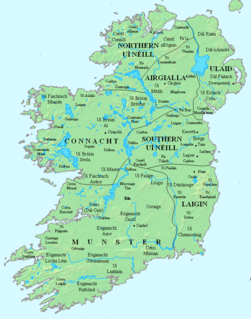Related Research Articles

Diarmait mac Cerbaill was King of Tara or High King of Ireland. According to traditions, he was the last High King to follow the pagan rituals of inauguration, the ban-feis or marriage to goddess of the land.
Áed mac Néill, commonly called Áed Oirdnide, was King of Ailech. A member of the Cenél nEógain dynasty of the northern Uí Néill, he was the son of Niall Frossach. Like his father, Áed was reckoned High King of Ireland. He was King of Ailech from 788 onwards and High King of Ireland from 797.

Domhnall Mac Murchada, called Domnall Midi, was High King of Ireland. He belonged to the Clann Cholmáin branch of the Uí Néill. Clann Cholmáin's pre-eminence among the southern Uí Néill, which would last until the rise of Brian Bóruma and the end of the Uí Néill dominance in Ireland, dates from his lifetime.
Áed mac Ainmuirech was high-king of the Northern Uí Néill. He belonged to the Cenél Conaill and was a distant cousin of Columba of Iona. He was the son of Ainmuire mac Sétnai, a previous possible high king. His mother was Bríg, daughter of Chobtaig, son of Ailill, son of Nath Í, son of Crimthann mac Énnai son of Énnae Cennsalach of the Uí Ceinnselaig dynasty from Leinster. He was born in 530 according to the Annals of Tigernach (596.2).
Niall mac Áeda, called Niall Caille to distinguish him from his grandson Niall mac Áeda, was High King of Ireland.
Áed mac Diarmato, called Áed Sláine, was the son of Diarmait mac Cerbaill. Legendary stories exist of Áed's birth. Saint Columba is said to have prophesied his death. His descendants, the Síl nÁedo Sláine—the seed of Áed of Slane—were prominent in 7th and early 8th century Ireland.
Fergal mac Máele Dúin was High King of Ireland. Fergal belonged to the Cenél nEógain sept of the northern Uí Néill. He was the son of Máel Dúin mac Máele Fithrich, a King of Ailech, and great grandson of the high king Áed Uaridnach. He belonged to the Cenél maic Ercae branch of the Cenél nEógain and was King of Ailech from 700 to 722.
Ainmuire mac Sétnai or Ainmire or Ainmere was a High King of Ireland from the Cenél Conaill branch of the Uí Néill. He was the great-grandson of Conall Gulban, founder of this branch. He ruled from 566 to 569. He was the first high king from the Cenél Conaill.
Eógan Bél mac Cellaig was a king of Connacht from the Uí Fiachrach branch of the Connachta. He was the grandson of the high king Ailill Molt. His reign began sometime after 500. His byname bél means "mouth" or "lip," supposedly because he received praise from all who encountered him as a child. Other sources claim he had a cleft lip.
Dauí Tenga Uma was a King of Connacht from the Uí Briúin branch of the Connachta.
Uatu mac Áedo was a King of Connacht from the Uí Briúin branch of the Connachta. He was the son of Áed mac Echach Tirmcharna. The kinglists place his reign after his father which would put his succession in the year in 575. Prof. Byrne preserves this arrangement but points out that the Annals of Ulster do not name him as king at his death obit and he does not agree that the early Uí Briúin kings held the overlordship in Connacht.
Máel Cothaid mac Máele Umai was a King of Connacht from the Uí Fiachrach branch of the Connachta. He was of the Fir Chera sept of this branch and was the grandson of Feradach mac Ross, a previous Connacht king. The king lists such as the Book of Leinster have placed his reign after his grandfathers and before Áed mac Echach Tirmcharna and give him a reign of three years. Prof. Byrne has placed him after Uatu mac Áedo.
Muirgius mac Tommaltaig was a King of Connacht from the Uí Briúin branch of the Connachta. He was the great-grandson of Indrechtach mac Muiredaig Muillethan, a previous king. The death of his father Tommaltach mac Murgail is recorded in the annals where he is called king of Mag nAi. Muirgius was of the Síl Muiredaig sept of the Uí Briúin. He reigned from 792 to 815.
Diarmait was a son of Áed Sláine. According to the Irish annals, he was High King of Ireland.
Blathmac was a son of Áed Sláine. According to the Irish annals, he was High King of Ireland.

Murchad mac Diarmato, called Murchad Midi, was an Irish king. One of four or more sons of Diarmait Dian, he succeeded his father as King of Uisnech at the latter's death in 689.
Follaman mac Con Congalt, also written Fallomon mac Con Congelt, was King of Mide, a kingdom of the Uí Néill in central Ireland in modern County Westmeath and County Meath.
Domnall mac Muirchertaig, called Domnall Ilchelgach and Domnall mac Maic Ercae, was said to be a High King of Ireland.

Tethbae was a confederation of túatha in central Ireland in the Middle Ages. It was divided into two distinct kingdoms, north Tethba, ruled by the Cenél Coirpri, and south Tethba, ruled by the Cenél Maini. It covered parts of County Westmeath and much of County Longford, counties which today are the far north-west part of the province of Leinster. In some cases Tethbae may refer to south Tethbae only.
Events from the 7th century in Ireland.
References
- Annals of Tigernach
- Annals of the Four Masters
- Annals of Innisfallen
- G. Keating, History of Ireland
- T.M. Charles-Edwards, Early Christian Ireland
- Francis J. Byrne, Irish Kings and High-Kings
- The Chronology of the Irish Annals, Daniel P. McCarthy